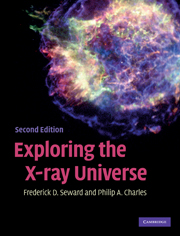Book contents
- Frontmatter
- Contents
- List of acronyms
- Foreword
- Chapter 1 Birth and childhood of X-ray astronomy
- Chapter 2 X-ray emission and interaction with matter
- Chapter 3 Tools and techniques
- Chapter 4 Solar system X-rays
- Chapter 5 X-ray absorption and scattering in the Interstellar Medium
- Chapter 6 Active stellar coronae
- Chapter 7 Early-type stars
- Chapter 8 Supernova explosions and their remnants
- Chapter 9 Neutron stars, pulsars, pulsar wind nebulae, and more supernova remnants
- Chapter 10 Cataclysmic variable stars
- Chapter 11 X-ray binaries
- Chapter 12 Black-hole X-ray binaries
- Chapter 13 Normal and starburst galaxies
- Chapter 14 Active galactic nuclei
- Chapter 15 Clusters of galaxies
- Chapter 16 The diffuse X-ray background
- Chapter 17 Gamma-ray bursts
- Index
- Plate section
Chapter 3 - Tools and techniques
Published online by Cambridge University Press: 05 June 2012
- Frontmatter
- Contents
- List of acronyms
- Foreword
- Chapter 1 Birth and childhood of X-ray astronomy
- Chapter 2 X-ray emission and interaction with matter
- Chapter 3 Tools and techniques
- Chapter 4 Solar system X-rays
- Chapter 5 X-ray absorption and scattering in the Interstellar Medium
- Chapter 6 Active stellar coronae
- Chapter 7 Early-type stars
- Chapter 8 Supernova explosions and their remnants
- Chapter 9 Neutron stars, pulsars, pulsar wind nebulae, and more supernova remnants
- Chapter 10 Cataclysmic variable stars
- Chapter 11 X-ray binaries
- Chapter 12 Black-hole X-ray binaries
- Chapter 13 Normal and starburst galaxies
- Chapter 14 Active galactic nuclei
- Chapter 15 Clusters of galaxies
- Chapter 16 The diffuse X-ray background
- Chapter 17 Gamma-ray bursts
- Index
- Plate section
Summary
X-ray detectors
The first instruments used for X-ray astronomy were developed originally for the detection of charged particles and γ rays emitted by radioactive material. These detectors respond to energy deposited by photoelectrons and, for higher energies, Compton electrons (discussed in Chapter 2). A fast electron creates a track of ionised material in the active volume of the detector. The detector collects either this charge or light from recombination of the ions. Electronic circuits then amplify this signal and record the time and amplitude of the event.
The proportional counter
The proportional counter is not only an efficient X-ray detector but also measures the energy of every photon detected. It was the workhorse of early cosmic X-ray observations and is still being used in modern instruments. However, the modifications necessary to adapt the simple laboratory counter to an X-ray detector capable of operating in the harsh environment of space were challenging.
The detector must have a large area to collect photons from weak cosmic sources and obviously a window thin enough to transmit X-rays. Yet the window has to be strong enough to keep the gas inside the detector from leaking into the nearvacuum of space and well supported to withstand the force of the gas pressure inside the detector. Many an early observation was lost by the failure of detector windows during rocket ascent out of the atmosphere and upon first exposure to space.
- Type
- Chapter
- Information
- Exploring the X-ray Universe , pp. 18 - 38Publisher: Cambridge University PressPrint publication year: 2010



